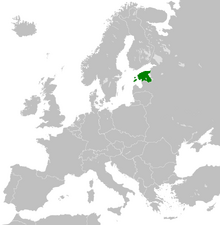| |||||||
| Anthem | "Mu isamaa, mu õnn ja rõõm" | ||||||
| Capital (and largest city) |
Talinn | ||||||
| Language | Estonian | ||||||
| Religion | Lutheranism; Irreligion; Orthodox Christianity | ||||||
| Ethnic Group | Estonians; Finns; Swedes | ||||||
| Demonym | Estonian | ||||||
| Government | Parliamentary republic | ||||||
| Legislature | Riigikogu of Estonia | ||||||
| Independence | from the Russian Empire | ||||||
| declared | February 24, 1918 | ||||||
| Currency | Estonian kroon (EEK)
| ||||||
| Time Zone | Eastern European Time (UTC+2) | ||||||
| summer | Eastern European Summer Time (UTC+3) | ||||||
| Internet TLD | .ee | ||||||
Estonia (Estonian: Eesti), officially the Republic of Estonia (Estonian: Eesti Vabariik), is a state in the Baltic region of Northern Europe. It is bordered to the north by the Gulf of Finland, to the west by the Baltic Sea, to the south and east by the Union of Soviet Socialist Republics. Across the Baltic Sea lies Scandinavia in the west and Finland in the north.
History

Flag of Estonia (1918-1946)
As a result of the abolition of serfdom and the availability of education to the native Estonian-speaking population, an active Estonian nationalist movement developed in the 19th century. In response to a period of Russification initiated by the Russian Empire in the 1890s, Estonian nationalism took on more political tones, with intellectuals first calling for greater autonomy, and later, complete independence from the Russian Empire.
When World War I ended, the February Revolution of 1917 occurred in Russia. The Provisional Government of Russia amalgamated the Governorate of Estonia and the Governorate of Livonia as the Autonomous Governorate of Estonia on April 12, 1917.

Estonian Declaration of Independence in Pärnu on February 23, 1918
Following the Bolshevik takeover of power in Russia after the October Revolution of 1917 and an attempt by the Estonian Bolsheviks to take over the political power in Tallinn on November 9, 1917, Maapäev, the provisional parliament of Estonia, forced to operate underground. In February, after the collapse of the peace talks between Soviet Russia and the German Empire, mainland Estonia was occupied by the Germans. Between the Bolshevik retreat and the arrival of advancing German troops, the Salvation Committee of the Maapäev proclaiming an independent, sovereign Estonian state in Pärnu on February 23 and in Tallinn on February 24, 1918.
After the collapse of the short-lived puppet government of the United Baltic Duchy and the withdrawal of German troops in November 1918, an Estonian Provisional Government retook office. A military invasion by the Red Army followed a few days later, however, marking the beginning of the Estonian War of Independence (1918–1920). The joint Scandinavian–Estonian forces successfully retreated the Red Army back to Soviet Russia by February 1919.

Konstantin Päts (1874–1956)
Independent Estonia then underwent a number of economic, social, and political reforms necessary to come to terms with its new status as a sovereign state. Economically and socially, land reform in 1919 was the most important step. Large estate holdings belonging to the Baltic nobility were redistributed among the peasants and especially among volunteers in the war of independence. Estonia's principal markets became Scandinavia, the United Kingdom, and western Europe, with some exports to the United States and to the Soviet Union.
A mass anticommunist and anti-parliamentary Vaps Movement emerged in the 1930s. Head of State Konstantin Päts then carried out a pre-emptive self-coup on March 12, 1934. State of emergency was declared and the Vaps Movement was disbanded, starting the "Era of Silence". During the Era of Silence, political parties were banned and the parliament was not in session between 1934 and 1938 as the country was ruled by decree from Konstantin Päts. It was also easier for the government to pass reforms, since there was no longer an organized opposition. The economy grew and the infrastructure, industry and education were developed by Päts's regime.



